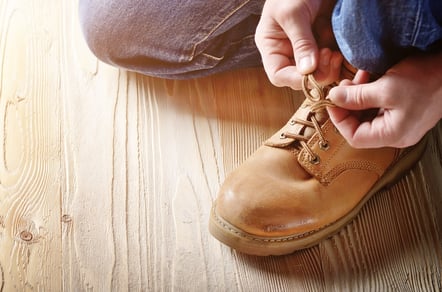Personal Protective Equipment (PPE) is mandatory in all industrial work environments. Hard hats, safety glasses, gloves, and harnesses are vital in protecting workers from accidents and injuries in any industrial or construction operation. Each employer has their own rules and regulations on the types of equipment needed to protect various parts of the body and many companies supply workers with most of the required PPE.
Unfortunately, the most often ignored, but possibly the most important aspect of protective gear, is a good pair of work boots. Purchasing work boots is often left up to the employees themselves which can result in the purchase of inadequate footwear. Investing in quality, heavy duty work boots provides safety, protection, and comfort to workers.

Why Invest in Proper Footwear?
In any profession that keeps you on your feet for most of the work day, having proper footwear is essential for maintaining one’s health while working. Support and comfort are important, but a high-quality pair of boots does more than just keep you comfortable. Proper boots are essential in preventing serious injury. Industrial and construction sites are hazardous and pose high risk of foot injuries from:
- Sharp objects piercing work boots
- Heavy objects falling on feet
- Careless use of heavy duty equipment and vehicles
- Sprains/fractures due to slips, trips and falls
- Electric shocks
What’s the Difference Between Adequate and Inadequate Footwear?
Proper footwear protects workers from a hazard work environment. The difference between adequate and inadequate footwear can be seen by a simple examination of the boot.
Adequate footwear will include:
- Traction: Bottoms of heavy duty work boots provide heavy tread to move safer about slippery or unfinished work spaces of an industrial work site. Better traction reduces slips, trips and falls.
- Reinforced Toes: This protection helps reduce foot injuries and guards against nail punctures, falling objects, or a slip of a chainsaw.
- Arch Support: Correct footwear helps combat fatigue as well as back pain with proper arch support. To ensure the arch properly fits you and is in the correct and comfortable position, slip the boot on and walk around the store.
Evaluating Boot Toe Support
Toe support is a key element in keeping feet safe in a hazardous work environment. There are three types of support commonly offered, each with their own set of pros and cons.
-
Steel: Maximum level of protection
| Pros: |
Cons: |
| Less expensive |
Heavy and uncomfortable |
| Max protection from falling objects |
Smaller toe box |
| |
Sets off metal detectors |
| |
Gets cold in winter |
-
Composite: (Kevlar, carbon fiber, plastic or fiberglass) Moderate level of protection
| Pros: |
Cons: |
| Good for extreme high or low temps |
Lower protection from impact or compression |
| Lighter than steel |
Can crack or shatter from falling objects |
-
Alloy: (Aluminum or Titanium) Maximum level of protection
| Pros: |
Cons: |
| 30-50% lighter than steel |
More expensive |
| Larger toe box |
Will set off metal detectors |
Because of the investment required in a quality pair of work boots, it is essential to make the right choice the first time. Prior to investing in proper footwear, employees should check with their companies to see if their company has specific requirements. Talking to the human resources department or your foreman can lead you in the right direction.
Comfortable boots that also protect feet are among the most valuable investments you can make for personal safety and performance.